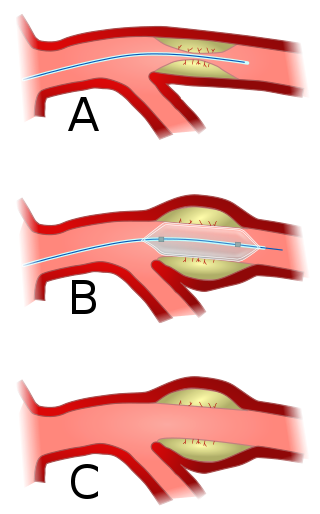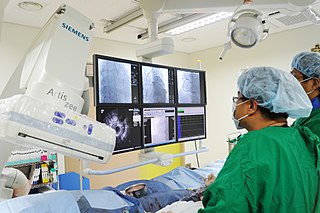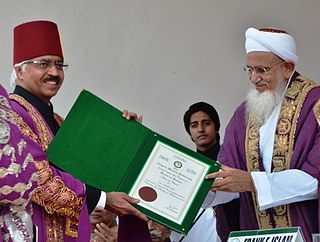Related Research Articles

Angioplasty, also known as balloon angioplasty and percutaneous transluminal angioplasty (PTA), is a minimally invasive endovascular procedure used to widen narrowed or obstructed arteries or veins, typically to treat arterial atherosclerosis.

In medicine, a stent is a tube usually constructed of a metallic alloy or a polymer. It is inserted into the lumen of an anatomic vessel or duct to keep the passageway open. Stenting refers to the placement of a stent. The word "stent" is also used as a verb to describe the placement of such a device, particularly when a disease such as atherosclerosis has pathologically narrowed a structure such as an artery.

A coronary catheterization is a minimally invasive procedure to access the coronary circulation and blood filled chambers of the heart using a catheter. It is performed for both diagnostic and interventional (treatment) purposes.

Restenosis is the recurrence of stenosis, a narrowing of a blood vessel, leading to restricted blood flow. Restenosis usually pertains to an artery or other large blood vessel that has become narrowed, received treatment to clear the blockage, and subsequently become re-narrowed. This is usually restenosis of an artery, or other blood vessel, or possibly a vessel within an organ.

Coronary thrombosis is defined as the formation of a blood clot inside a blood vessel of the heart. This blood clot may then restrict blood flow within the heart, leading to heart tissue damage, or a myocardial infarction, also known as a heart attack.

Percutaneous coronary intervention (PCI) is a minimally invasive non-surgical procedure used to treat narrowing of the coronary arteries of the heart found in coronary artery disease. The procedure is used to place and deploy coronary stents, a permanent wire-meshed tube, to open narrowed coronary arteries. PCI is considered 'non-surgical' as it uses a small hole in a peripheral artery (leg/arm) to gain access to the arterial system, an equivalent surgical procedure would involve the opening of the chest wall to gain access to the heart area. The term 'coronary angioplasty with stent' is synonymous with PCI. The procedure visualises the blood vessels via fluoroscopic imaging and contrast dyes. PCI is performed by an interventional cardiologists in a catheterization laboratory setting.

A drug-eluting stent (DES) is a tube made of a mesh-like material used to treat narrowed arteries in medical procedures both mechanically and pharmacologically. A DES is inserted into a narrowed artery using a balloon. Once the balloon inside the stent is inflated, the stent expands, pushing against the artery wall, keeping the artery open, thereby improving blood flow. The mesh design allows cells to grow through and around it, securing it in place.
The history of invasive and interventional cardiology is complex, with multiple groups working independently on similar technologies. Invasive and interventional cardiology is currently closely associated with cardiologists, though the development and most of its early research and procedures were performed by diagnostic and interventional radiologists.
Terumo Corporation was founded in 1921 as Red Line Thermometer Corporation by a group of medical scientists led by Dr. Kitasato Shibasaburō to produce medical thermometers in Japan.

A coronary stent is a tube-shaped device placed in the coronary arteries that supply blood to the heart, to keep the arteries open in patients suffering from coronary heart disease. The vast majority of stents used in modern interventional cardiology are drug-eluting stents (DES). They are used in a medical procedure called percutaneous coronary intervention (PCI). Coronary stents are divided into two broad types: drug-eluting and bare metal stents. As of 2023, drug-eluting stents were used in more than 90% of all PCI procedures. Stents reduce angina and have been shown to improve survival and decrease adverse events after a patient has suffered a heart attack—medically termed an acute myocardial infarction.

A prostatic stent is a stent used to keep open the male urethra and allow the passing of urine in cases of prostatic obstruction and lower urinary tract symptoms (LUTS). Prostatic obstruction is a common condition with a variety of causes. Benign prostatic hyperplasia (BPH) is the most common cause, but obstruction may also occur acutely after treatment for BPH such as transurethral needle ablation of the prostate (TUNA), transurethral resection of the prostate (TURP), transurethral microwave thermotherapy (TUMT), prostate cancer or after radiation therapy.
Nicholas George Kounis is professor emeritus of cardiology in the University of Patras and scientific cardiology advisor at Saint Andrews State General Hospital Patras and at the Department of cardiology of University of Patras Medical School, Patras, Greece.
Biotronik is a limited partnership multi-national cardiovascular biomedical research and technology company, headquartered in Berlin, Germany.
A dual therapy stent is a coronary artery stent that combines the technology of an antibody-coated stent and a drug-eluting stent. Currently, second-generation drug-eluting stents require long-term use of dual-antiplatelet therapy, which increases the risk of major bleeding occurrences in patients. Compared to drug-eluting stents, dual therapy stents have improved vessel regeneration and cell proliferation capabilities. As a result, dual therapy stents were developed to reduce the long-term need for dual-antiplatelet therapy.
Christodoulos I. Stefanadis is Professor of Cardiology in the Medical School of the University of Athens. Professor of Medicine, Department of Medicine, Division of Cardiology, Emory University, Atlanta U.S.A.Professor of Internal Medicine, Cardiology, Yale University, New Haven, Connecticut, USA. He has been recognised as the top researcher in the field of Cardiovascular medicine in the last 20 years with the most original research publications in peer review journals. Some of his main research interests include coronary heart disease, detection and treatment of vulnerable atheromatic plaque, aortic elastic properties, mitral valve disease, interventional treatment of resistant hypertension and designing many catheter types used for various diagnostic and therapeutic interventional procedures.

Ashok Seth is an Indian interventional cardiologist, credited with the performance of over 50,000 angiograms and 20,000 angioplasties, which has been included in the Limca Book of Records, a book for achievements and records from an Indian perspective. He is a Fellow of the Royal Colleges of Physicians of London, Edinburgh and Ireland and serves as the chief cardiologist, holding the chairs of the department of cardiovascular sciences and cardiology council at the Fortis Healthcare. Seth, a recipient of the Order of Isabella the Catholic, was honored by the Government of India with the fourth highest Indian civilian award of Padma Shri, in 2003, followed by Padma Bhushan, the third highest Indian civilian award, in 2015.
Eckhard U. Alt is a German scientist and physician known for his contributions in cardiology and research.
Daljeet Singh Gambhir is an Indian cardiologist, medical academic, researcher and inventor and the Group Director of Cardiology at Kailash Group of Hospitals and Heart Institute, Noida. He is the inventor of Infinnium Paclitaxel-Eluting Stent, a reportedly cheaper drug-eluting stent which he first presented at the EuroPCR meeting held in Paris in 2003. A fellow of the National Academy of Medical Sciences and an honorary fellow of the Indian College of Cardiology, he is reported to have performed over 10,000 coronary interventions. The Government of India awarded him the fourth highest civilian honour of the Padma Shri, in 2016, for his contributions to medicine.
Donald S. Baim was a researcher and clinician in the field of interventional cardiology. Baim's primary research focused on coronary blood flow, catheter intervention in heart disease, and congestive heart failure. His work helped to shift the use of catheters from a purely diagnostic tool to a therapeutic tool. After receiving a medical degree from Yale and initial medical training, residency and a fellowship at Stanford University Medical Center, Baim spent the bulk of his career at Beth Israel Hospital and at the Brigham and Women's Hospital in Boston. In 1993, Baim founded the Beth Israel Hospital's Cardiovascular Data Analysis Center (CDAC) -- later to be named Harvard Clinical Research Institute (HCRI). Baim died of cancer in November 2009. In October 2016, HCRI changed its name to the Baim Institute for Clinical Research.
MicroPort is a multinational medical technology developer and manufacturer that is primarily headquartered in Shanghai, China. It mainly designs and produces medical devices for a range of fields including cardiology, interventional radiology, orthopedics, electrophysiology, and surgical management. MicroPort is considered one of the global Medtech Big 100 and has been consistently known as the leading spender in research and development by percentage of revenue.
References
- ↑ "Our Products - Cleanrooms.net". Archived from the original on 2011-07-23. Retrieved 2010-03-30.
- ↑ "Alvimedica, ilaç kaplı stent üretti, 2010'da kullanılacak".
- ↑ "Alvimedica". Archived from the original on 2010-03-07. Retrieved 2010-03-30.
- ↑ "ACC 2010 Home". Archived from the original on 2010-03-27. Retrieved 2010-03-30.
- ↑ "Turkey eyes boom in medical investments with new project". www.todayszaman.com. Archived from the original on 14 September 2012. Retrieved 6 June 2022.
- ↑ "Home". stentforlife.com. Archived from the original on 2013-04-04. Retrieved 2012-11-08.
- ↑ "Türk Kardiyoloji Derneği". Archived from the original on 2011-10-06. Retrieved 2010-03-30.
- ↑ "ESC | Membership | National Societies | Spotlight on the 25th Congress of the Turkish Society of Cardiology". Archived from the original on 2011-07-26. Retrieved 2010-03-30.
- ↑ "Stent for life". www.europcronline.com. Archived from the original on 25 June 2009. Retrieved 6 June 2022.